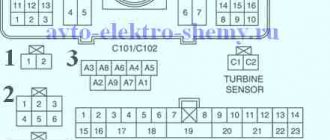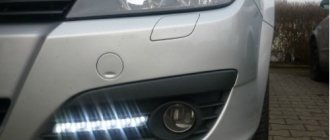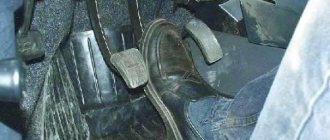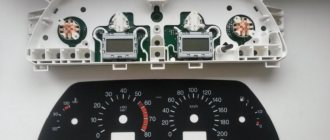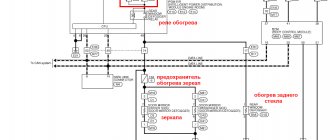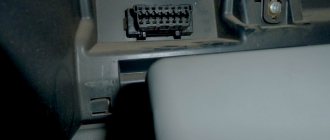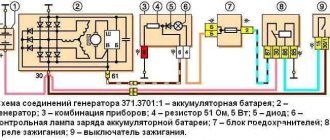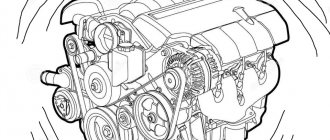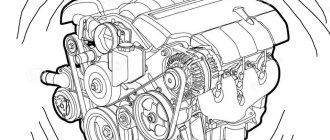Not a single house or apartment can do without engineering systems. Everyone is so accustomed to these benefits of civilization that they take them for granted, and begin to appreciate them only at the moment when the usual, uninterrupted operation of communications is disrupted. The biggest “trouble” that makes a person practically helpless happens when the power suddenly goes out. And in this case, you can suspect a short circuit, which can provoke very unpleasant consequences, the most dangerous of which is a fire. The most important tasks of the owner or electrician are to determine the cause of the short circuit and locate the problem area. When searching on your own, the main question becomes how to find a short circuit in hidden wiring. There are several options for solving this “puzzle”.
Reason three. Faulty wiring
Over time, any engineering communications become unusable, electrical wiring is no exception and can also lose its operational properties, subsequently causing the circuit breaker protection to trip. Here the second protective function of the circuit breaker comes into play - protection against short circuit currents.
In addition to natural aging, the quality of the electrical network can significantly deteriorate as a result of improper operation of electrical communications (overload, etc.) or under the influence of external factors, such as flooding of the apartment by neighbors above, fire, etc.
Determining the malfunction of electrical wiring is much more difficult than checking the functionality of electrical household appliances, but nevertheless it is possible to identify the cause. The sequence of standard actions in this case may be as follows:
- De-energize the facility's electrical network;
- Open all distribution boxes within the house and visually inspect them. If there is melted insulation or poor contact of the conductors, re-disconnect the conductors in accordance with the electrical diagram.
- Dismantle all sockets, switches and lighting equipment one by one and inspect them. If there is a poor connection or melted insulation, reconnect the cores, having first cleaned them of old oxide. Then install the electrical equipment in the reverse order.
If the above actions do not produce a noticeable result, then the reason for the protection to be triggered is a short circuit in the electrical wiring inside the walls. It is very difficult to identify the location of such a short circuit (expensive devices are used for these purposes - short circuit alarms, thermal imagers), which is why, at home, the main goal of the contractor will be to find the problem line for its further replacement.
You can determine such an area using a multimeter or a regular test by following these steps:
- De-energize the facility;
- Switch the multimeter to the continuity mode (when the probes are closed, a sound signal is emitted, indicating that the circuit is closed);
- Disconnect all conductors in the junction boxes (for ease of subsequent installation, it is recommended to first mark the wire strands and draw up a wiring diagram);
- All electrical consumers should be turned off and lighting devices should be unscrewed from their sockets;
- You should check all rooms of the apartment for short circuits one by one. To do this, you should check all the incoming and outgoing areas in the distribution box (connecting the probes of the device with the conductors of the same route). If there is a short circuit (the device will signal with a sound), find the “problem area”.
- Having completed all the electrical connections in the apartment in reverse order, without the short-circuited link, you should apply voltage and make sure that the electrical wiring is working correctly.
Subsequently, the broken section of the wiring should be replaced and put into operation.
Danger in the house
A malfunction, called a “shorty” in electricians’ slang, in a household network without a protective shutdown and with “bugs” instead of fuses, is fraught with serious consequences. Always causes material damage.
In a “safe” scenario, the wiring will burn out at the point of the short circuit, the electrical fittings will melt at the point of contact with metal parts, and the electrical equipment will fail.
In an extreme situation, if you do not turn off the power in time, a fire may occur in a private home. For example, an arc flash will ignite insulation or an electrical appliance, then the fire will spread to adjacent areas of the facility. This will lead to material losses with the consequences described in the reports of the Ministry of Emergency Situations.
Definition and physical justification for the occurrence of a malfunction:
A short circuit is the occurrence of electrical contact between two points in sections of an electrical circuit with different values of electrical potential, if such a connection is not provided for by the design of the device. Which leads to disruptions in work.
In contrast to a long circuit, which is the connection of electrical appliances to the network, a short circuit is a circuit closed along a short path, bypassing consumers.
The power system of a facility, including a residential building, consists of electrical devices and linear elements for the passage of electric current to consumers from the input distribution device.
It ensures uninterrupted operation of power units, household appliances, heaters and lamps.
The supply of operating voltage to electrical receivers is provided by loops made of two-core and stranded wire. For wiring, conductors with copper or aluminum conductors in a dielectric sheath are used (rubber, polyvinyl chloride, fabric braiding are used).
In the normal state, conductors with different electrical potentials “phase” and “zero” do not interact; they are separated by a dielectric layer. If an electrical contact occurs in an emergency situation, the current immediately increases like an avalanche. This is due to the fact that the network represents an alternating voltage source U = 220 V or U = 380 V, the value of which practically does not change. Consequently, the current at a constant voltage is determined by the value of the resistance in the load Icz = U/Rcz, where the value of Rcz in the denominator is 0.
In accordance with the physical Joule-Lenz law, a flowing high current causes a significant release of heat, heating closed conductors to a temperature of 5000 °C.
If the circuit breaker does not operate, the heating may reach critical levels and cause a fire in the insulation or flammable materials in contact with the wiring.
Possible consequences
A short circuit is a negative phenomenon that can lead to fire and damage to household appliances. But other problems caused by the defect can also be identified:
- Melting veins. If they explode, they can cause harm to human health.
- Ignition of insulation. Relevant for low-quality insulating layers or made of flammable materials.
- Equipment breakdown.
To prevent all negative consequences, you need to find the short circuit in time and eliminate it.
Types of wiring short circuits, their causes and search methods
It would seem that the reasons for a short circuit in power wiring and their varieties are different issues, but in fact they are closely intertwined. In fact, a short circuit is a consequence of a number of reasons why the phase wire is in direct contact with the neutral wire, or the insulation between them does not prevent the occurrence of an arc discharge (of course, if there is voltage on the conductors). The main reasons why the wiring shorts and what the consequences may be, by which you can determine the location of the breakdown, are as follows:
Physical wear and tear of insulation
Occurs over time and due to even minor but regular temperature changes.
Usually, in this case, the insulation gradually becomes brittle from flexible - cracks appear on it, in which moisture or dust can accumulate. In the event of an unfavorable combination of circumstances, this can provoke the occurrence of a short circuit through a microarc, and this is the most difficult case from the point of view of troubleshooting.
The search for the vast majority of faults in an electrical circuit occurs on the principle of checking “weak links” - these are any contacts, transitions - all those places where the outer insulation of the cable is exposed during installation. Therefore, in hidden wiring, troubleshooting should always begin in sockets, boxes and panels.
As a result - in this case, a careful inspection of the wiring is carried out - if the circuit breaker is already knocked out, then perhaps the place where the insulation is damaged will be burnt and it will become visible. In some cases, it is necessary to “stress test” the wiring by applying increased voltage to it. This is a rather extreme method, because in essence you have to provoke a full short circuit in the electrical wiring, after which the location of the fault is visible to the naked eye.
For hidden wiring and finding microcracks in the insulation, you can also use a megohmmeter, but it will only show the presence of a short circuit in a localized section of the electrical circuit, and will not be able to determine the location of its occurrence.
After we find the fault, then, depending on the general condition of the wiring, we must decide whether to change the cable or make do with restoring the insulation using electrical tape.
An example of the operation of a megohmmeter is in the video:
Damage to insulation by rodents
This is a fairly common occurrence in rural areas, and in industrial conditions such breakdowns are far from uncommon - mice gnaw through the outer insulation of cables, then the inner insulation and short-circuit the neutral phase.
The difficulty in finding such a malfunction may lie in the fact that it is unknown where the mouse could have chosen a place for its “meal”. But on the other hand, usually the location of the damage is clearly visible, so a superficial inspection of the wire, albeit along its entire length, is sufficient.
It should be taken into account that a complete short circuit does not always occur here - sometimes the mouse can partially damage the insulation and short the wires not directly, but through itself. In this case, there is a high probability of finding the location of the wire damage by looking at the dead animal, which is chained to the chewed wire by a spasm from the electric current. Although sometimes it happens that the mouse is thrown away from the cable, especially if it manages to short-circuit the wires directly and a complete short circuit occurs in the chewed wiring.
How to prevent an encounter with a short circuit?
Attention to all elements and regular checking of the network is the best way to avoid getting familiar with short circuits, and therefore, searching for an answer to the question of how to find a short circuit in hidden wiring. Periodic inspection of the electrical network will help reduce the likelihood of encountering a dangerous phenomenon.
It will not give a complete guarantee, since not everything depends on the condition of the home wiring. However, it is still possible to minimize the chance of encountering a short circuit.
If a socket or switch raises suspicions due to heating, sparking, or the appearance of a subtle but noticeable odor of plastic, then it is better not to wait for an emergency, but to replace or repair the device in time. Checking the electrical network once every six months is mandatory
During the inspection, close attention must be paid to the condition of the insulating materials. Even the slightest change in their color is a sufficient reason for replacement. The ideal is to install a machine equipped with a residual current device (RCD)
If the circuit breaker de-energizes the network when a short circuit occurs, the RCD will protect the owners in case of contact with exposed wires. Before starting any serious work on the walls, you need to make sure that there is no electrical wiring in the area. This requirement is often forgotten, and then they pay for their inattention. The cross-section of the conductors must correspond to the total power of all household appliances, which in apartments and private houses is becoming more and more every year. A minimum amount of electrical equipment in “wet” rooms is encouraged. Sockets must have an appropriate moisture protection class: minimum IP44.
By fulfilling all these conditions, the owners minimize the chance of encountering a short circuit. A few words must be said about wiring installation. It is not recommended to lay cables tightly, as this increases the risk of damage.
How to find a short circuit in an apartment's wiring
The most difficult thing is to find the location of the short circuit in the apartment wiring if the hidden installation of the cable was carried out in grooves. To determine the location of the short circuit. Electricians use a megohmmeter. It’s unlikely that you have such a device, so to find the health of your home network, use devices such as a multimeter, a pointer tester, or a light bulb with a battery.
For such purposes, it is not recommended to use a multimeter, since the resistance measurement mode is carried out at a low current (microamperes), which is not enough to break down the deposit at the point of the circuit. It is better to take a dial tester or a light bulb with a battery. Finding the location of the fault should begin by turning off the input circuit breaker. All work with electrical wiring is carried out only in the absence of mains voltage.
Continuity from battery and light bulb
Let's look at a case where you don't know where the short circuit occurred, that is, you didn't detect the smell of burnt insulation or hear sparking in the wires. Before troubleshooting, you must turn off all light switches in all rooms and remove the plugs from the sockets of all electrical consumers.
If the input circuit breaker is located in the entrance electrical panel, unscrew the phase wire from the bottom terminal of the circuit breaker and check for short circuits. tester in the lowest resistance limit mode. The needle of the device has not fallen to zero or close to it (there is no short circuit), then turn on the lighting in all rooms in turn, and then turn on all household appliances also in turn.
Pointer tester for wire continuity
If you find a source of short circuits, do not turn it on until it is repaired. And if a fault is not detected and the tester shows “0” with all electricity consumers turned off, proceed to the next step. In the case when the input machine is located in the entrance panel, the wires from the input machine to the first junction box in the apartment ring.
Before this, disconnect the ends of the wires coming from the input machine in the box. If a short circuit is not detected, connect the tester to the wires in the box, but from the apartment, and call all the remaining wiring from this box. There is a short circuit. Then disconnect the wires from the junction box of the last room.
If short circuit is still detected by the tester, they take turns disconnecting the wires going to the junction boxes of other rooms until the room with the fault is detected. In this room, first check all sockets. The faulty socket is replaced with a new one.
If the short circuit is not found again, unscrew all the wires from the sockets and lighting in the junction box one by one. Let's say we found a fault in the wires leading to the outlet. If the electrical wiring is hidden, you need to pull the cable out of the groove, clean it and lay a new piece of cable.
The cable needs to be changed because its insulation is already damaged by the high temperature of the short circuit current. If you don’t want to damage the wall, then you can run the cable from the adjacent socket (if the load on the faulty socket is small) through the cable channel down to the baseboard and lift it to the socket. When the outlet itself is faulty, it needs to be replaced.
It is not advisable to clean the socket, since carbon deposits penetrate deep into the plastic, which can cause a re-short circuit. In the wiring of new apartments, a cable with a protective grounding conductor (color yellow-green) is installed. It is also called regarding phase and zero.
Repair of damaged area
Repairing the damaged area is quite simple (see Do-it-yourself diagnostics and repair of electrical wiring). Although ideally a new wire should be installed, temporary repairs can be made to this area.
To do this, it is important to use a wire with a cross-section no smaller than the existing one and made of the same material.
So:
First of all, we will have to remove the layer of plaster under which the wiring is hidden
This should be done carefully so as not to damage it further. We make sure that we have correctly identified the location of the damage by the presence of a break or traces of a short circuit. We cut the damaged wire and connect to it a small insert made of wire of the same material. Connection is best done by soldering or pressing
This will significantly reduce the depth of the required niche for subsequent plastering of the wire.
Repair of damaged wires
- It is best to use heat shrink as insulation, which will be much easier to put on and which will again save space.
- After repairs, check the functionality of your network by applying voltage and turning on the load. If possible, apply a higher load and check that there is no increased heat at the joints. If everything is fine, you can plaster the niche with the wire.
- It is better to reapply voltage and put it into operation after the plaster has dried.
Other reasons for AV shutdown
It should be noted that there are other (unlikely) reasons for a circuit breaker tripping. Therefore, they should not be overlooked either.
- Activation of protection in the AV when an incandescent lamp burns out at the moment of switching on. This is not a problem, as it is related to the physical properties of the lighting device, in which the starting current of the lamp can be 10 times higher than the rated current of the circuit breaker. To prevent this from happening, incandescent lamps should be abandoned in favor of modern energy-efficient systems equipped with soft start.
- Spontaneous shutdown of the circuit breaker as a result of its failure is checked by replacing the circuit breaker with an identical analogue.
- Poor quality of installation at the point where the terminals are connected to the machine. If there is poor contact between the conductors at the connection points, overheating may occur, which will trigger the thermal release. In this case, the revision will involve a new reconnection of the supply and outgoing conductors with a good fit. If there are traces of deformation on the circuit breaker as a result of melting, then such a circuit breaker must be replaced.
Short circuit, methods for finding it
Consider the case where your fuse blows. There are several types of short circuit, in the first case your fuse burns out instantly, immediately after its installation in the fuse block or during a short period, in a matter of moments after installation, but not instantly. This means that in the first case, the conductor through which it goes “plus” has direct direct contact with the “ground” of the car body, this option is a little easier in troubleshooting. It is always more difficult to identify the cause of a malfunction when it is weak or spontaneous in nature, with a tendency to appear and disappear.
When searching for a short circuit, the most important thing is to determine in which part of the circuit the short circuit occurs. When searching, I recommend that you arm yourself with a test light, a long piece of wire, a book or an electrical diagram of the electrical equipment of your car. If your fuse blows, then the short circuit is located in the section of the circuit from the fuse block to the device that is powered by this fuse.
I wrote “if possible” because not all electricity consumers are easily accessible, and many are located in places where this procedure can only be performed by a specialist or a person who has already encountered this. For example: if you determine that you have a short circuit in the direction indicator or hazard warning circuit of a VAZ 2105 car, you will need to disconnect the plug from the hazard warning switch, which is located on the right side of the steering column; if, when you turn it off and install the fuse, the short circuit disappears, you need go further along the wiring, and the relay for the turn signals and hazard warning lights is located under the dashboard, which I do not advise you to remove alone if you have not had such experience.
Above, I advised you to use a test light and a piece of wire when searching, now I’ll explain why. How we defined a short circuit is when the wiring or some part of the device connects or has contact with the ground of the car, we make a circuit by connecting a long wire to the “plus” of the battery and a control light, however, it can just be a control light with one long part. When looking for a short circuit, you must have the battery disconnected, but in this case, you will need to completely disconnect everything from the positive, and the negative ground must be connected to the car.
We connect the second terminal of our test lamp to the fuse block, connect it to the place where this formed minus comes from, since when we insert a fuse, it immediately blows out, which means a minus is formed at one output, and a positive voltage is applied to the second, as expected. When we connect a light bulb to this terminal, in the event of a short circuit, it will immediately light up brightly. Now, according to the scheme, we will turn off all electricity consumers that are powered by this fuse. And we will observe the behavior of the light bulb, how it burns, as soon as we disconnect the device causing the short circuit, the light bulb should either go out or shine dimmer, which will correspond to the fact that we have found the cause of the short circuit.
Short circuit, methods for finding it
Consider the case where your fuse blows. There are several types of short circuit, in the first case your fuse burns out instantly, immediately after its installation in the fuse block or during a short period, in a matter of moments after installation, but not instantly. This means that in the first case, the conductor through which it goes “plus” has direct direct contact with the “ground” of the car body, this option is a little easier in troubleshooting. It is always more difficult to identify the cause of a malfunction when it is weak or spontaneous in nature, with a tendency to appear and disappear.
When searching for a short circuit, the most important thing is to determine in which part of the circuit the short circuit occurs. When searching, I recommend that you arm yourself with a test light, a long piece of wire, a book or an electrical diagram of the electrical equipment of your car. If your fuse blows, then the short circuit is located in the section of the circuit from the fuse block to the device that is powered by this fuse.
I wrote “if possible” because not all electricity consumers are easily accessible, and many are located in places where this procedure can only be performed by a specialist or a person who has already encountered this. For example: if you determine that you have a short circuit in the direction indicator or hazard warning circuit of a VAZ 2105 car, you will need to disconnect the plug from the hazard warning switch, which is located on the right side of the steering column; if, when you turn it off and install the fuse, the short circuit disappears, you need go further along the wiring, and the relay for the turn signals and hazard warning lights is located under the dashboard, which I do not advise you to remove alone if you have not had such experience.
Causes of short circuit
The result of a short circuit in new electrical wiring can only be an installation error - either mechanical damage to the wires during their installation and fastening, or their incorrect connection in the junction box. Wires that have the same core insulation colors, as well as using a cable from the same manufacturer, will help to avoid an erroneous connection.
In old wiring, the main cause of short circuits is the destruction of the wire insulation due to age or constant humidity (for example, in the kitchen or bathroom). There is only one prevention - timely replacement of outdated wires and cables.
Another cause of short circuit is a faulty household electrical appliance. The easiest way to find such a fault in the electrical wiring is to turn on all the electrical appliances in the apartment one by one and wait for the machine in the electrical panel to “trigger.” The one he passed out on is our “hero”.
It is important to take into account that only circuit breakers with electromagnetic releases are triggered by a short circuit. Therefore, it is necessary to install circuit breakers that have both thermal releases (in case of network overload) and electromagnetic release (in case of short circuit). Almost all circuit breakers on sale have double protection.
Remedies and prevention
First, they get rid of the reasons that caused the short circuit. The burnt wiring is replaced with new wires. Radio components and coils that have become unusable are replaced with similar new components.
Prevention of short circuits involves installing safety automatics, voltage stabilizers, replacing old equipment and worn wiring.
Safety circuit breaker block
Timely measures taken to prevent the occurrence of short circuits will preserve expensive equipment, electronic devices, and household appliances. We must remember that a short circuit can destroy not only property, but also people’s lives.
Features of checking wires included in various devices
First, let's look at the features of work in conditions where the on-board wiring of a modern car is checked using a multimeter.
Automotive wiring
The specificity of this situation is that the wiring in the case under consideration consists of one linear conductor with a supply voltage of 12 Volts. In this case, the metal body of the car is used as the second (common or “ground”) conductor, where, as a rule, there is nothing to break.
To prepare the on-board network for inspection, you first need to disconnect the positive terminal from the battery, after which you can safely begin work. Testing of on-board wiring is organized according to the previously described linear circuit testing scheme.
When checking the “ground” of a car, the main attention is paid to the quality of contact of the supply terminals with the body
Electric heating element
Based on the indicator readings on the multimeter, it is possible to make a continuity test on an element such as a water heating element. During the test, the control probes of the device touch the two contact plates of the heater and evaluate its internal resistance using the indicator.
If the display shows about a few ohms, then without a doubt the element is working. With large values on the screen corresponding to a break in the line being tested, you can immediately say that the heating element is damaged and must be replaced.
In addition to the heating element itself, when checking boilers and similar devices, it is very important to ring the supply cable for unwanted contact with the device body. For this purpose, one of the multimeter probes is connected in turn to the input contacts; while the second end is constantly held on the heater body
If the digital multimeter shows some resistance during measurement, this means that the protective sheath of the supply cable is damaged. To prevent electric shock to the user, it should be replaced with a new one.
Other household appliances and parts
Using a multimeter, you can test the power circuit of any lighting device by testing the wiring and auxiliary elements (switches, in particular) for a short circuit or open circuit. To do this, first of all, you should ring two linear chains ending directly at the contacts of the light bulb.
When testing linear chains, be sure to check the serviceability of the switch located in one of them, as well as the reliability of connecting the conductors to its contacts.
We also note that using this method it will be possible to ring the windings of a linear transformer or electric motor and verify their integrity or the presence of a break (short circuit).
In conclusion, let us remind you once again that using a multimeter you can check not only individual wires or wiring hidden in the thickness of walls, but also any other electrical devices and parts.
Many car enthusiasts, when problems arise with electrical wiring, immediately begin frantically looking for a familiar auto electrician to solve the problem, citing the fact that they do not understand electricity. In fact, there is nothing difficult about carrying out electrical diagnostics yourself. To do this, you will need a multimeter and a little knowledge, which we will try to outline for you in this article. Read the information below and you will not have any questions about how to find a short circuit in a car or, conversely, how to find a broken wire in a car.
What is a short-circuited turn
Hidden wiring is convenient and economical!
Many electrical appliances and devices use coils - these are chokes, transformers, magnetic starters, contactors. Electric motors have windings on the armature and stator. Short-circuited turns may occur in these parts. There are several reasons for the appearance of this type of short circuit:
- poor-quality winding of wires (overlapping turns, excessive tension);
- mechanical damage to insulation;
- moisture penetration;
- insulation burnout from a power surge.

